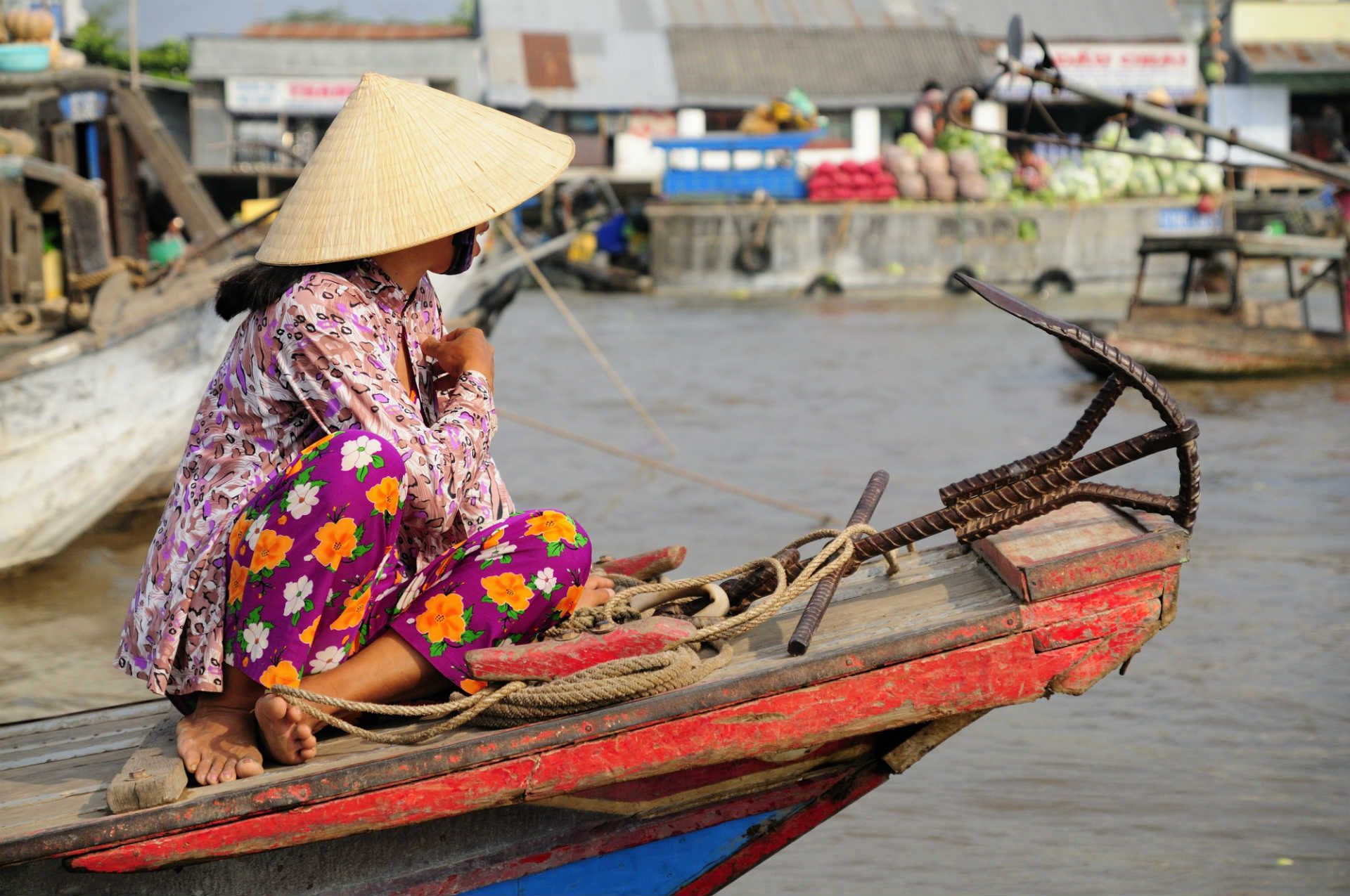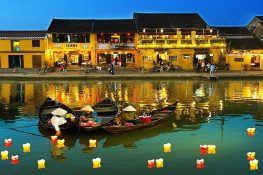If you intend to see a bit of everything, you need to work around the regional weather differences. Overall, autumn / winter (September – December) and spring (March and April) are probably the most favourable seasons if you’re planning to cover the whole country.
But, the best time to visit Vietnam varies depending on the region, as the country experiences a diverse climate due to its elongated geography.
North Vietnam
In the North, including cities like Hanoi and Sapa, the ideal time to visit is from October to April when the weather is cooler and less humid, perfect for trekking and sightseeing.
- Best Time: October to April
- Weather: Cooler and less humite
- Activities: Trekking, sightseeing, cultural visits to temples and historical site
- Avoid: May to September due to hot and humid conditions, heavy rainfall
South Vietnam
The Central region, encompassing places like Hue, Da Nang, and Hoi An, is best visited from February to May when the rainfall is moderate and the temperatures are warm but not scorching.
- Best Time: February to May
- Weather: Moderate rainfall, warm temperatures
- Activities: Beach visits, historical tours, water sports
- Avoid: Late May to November due to typhoon season and heavy rains
South Vietnam
The South, including bustling Ho Chi Minh City and the Mekong Delta, is favourable for travel from December to April, avoiding the monsoon season and making the most of the tropical climate.
- Best Time: December to April
- Weather: Dry and less humid
- Activities: Exploring urban areas, river cruises, visiting tropical forests
- Avoid: May to November due to monsoon season, high humidity and rainfall

Make sure to visit the rice fields in Sapa © Shutterstock
Weather in Vietnam by month
Not sure about the best time to visit Vietnam? We divided Vietnam’s weather by month to help you decide the optimal time for your visit, ensuring that you’re prepared for whatever climatic nuances each region has to offer. From the chilly winters in the north to the tropical summers in the south, here’s what you can expect in terms of weather throughout the year in this captivating country.
Visiting Vietnam in January
In January, cold winter weather hits the north. This is often accompanied by fine persistent mists, which could spoil your views at Ha Long Bay. There’s also the chance of ground frost in higher regions, or even a rare snowfall. Don’t let it put you off outdoor activities though – while January is the coldest month in mountainous areas, such as Sa Pa, rainfall is at its lowest, making perfect trekking conditions. Hanoi averages a pleasant 20ºC.
The southern end of the country is firmly into the dry season come January, so it’s a good time to explore cities such as Ho Chi Minh. And for post-city downtime make for beaches within easy reach of the capital, such as at Phan Thiet and Mui Ne. It’s a fantastic time to try water-related activities, such as diving, around Phu Quoc.
Nha Trang and Da Nang beaches also start to beckon in January, as the central coast sees the tail end of the rains.
Visiting Vietnam in February
Vietnam sees optimum weather conditions all-round in February. The south and the central coast, are perfect for beach bums, with just a smattering of rain perhaps on the beaches between Hoi An and Da Nang. If you can tear yourself away from the sands near Da Nang to dip into the back streets of the city, you’re in for some of the best street food in Vietnam. The north sees the chill lifting, leaving clear and warm days for hiking and exploring the region.
Dominating the calendar is Tet, or the Lunar New Year, and the biggest festival in Vietnam. While it’s wonderfully festive throughout, note that much of the country shuts down during this period, such as restaurants and museums. Also, accommodation can be hard to come by, as the Vietnamese take their holidays, and the transport system is stretched.
Visiting Vietnam in March
In terms of the weather, March is perhaps the best month to visit Vietnam, especially if you want to see the whole country. Temperatures in the north are rising, making March a perfect time for adventure and trekking in the highlands and mountains. Clear skies around Ha Long Bay make it an ideal time to take a boat tour, stopping off at the beguiling Cat Ba Island.
Dry weather means you can visit the awesome Phong Nha Caves in Phong Nha-ke Bang National Park, which boasts the world’s biggest cave.
You can be sure of sunshine and hot days in the south, which means lazy days on the beaches and water-based activities are a must, also on beaches on the central coast, such as at Nha Trang.

Ha Long Bay, Vietnam © Shutterstock
Visiting Vietnam in April
Temperatures in the north are rising in April as summer approaches, and some rain is not uncommon. But it’s still very pleasant and great for hiking, with spring flowers in full bloom making the region especially beautiful.
The centre of Vietnam entices with blue skies and sunshine, so make for charming town of Hoi An and the nearby beach of An Bang, and the broad sands at Da Nang. Further south, Nha Trang is at its best. Temperatures in the city of Hué are agreeable and the highlands experiences great weather at this time.
There’s a chance of some rain in southern Vietnam, but with mostly clear skies and temperatures hitting 31ºC it’s still great for sun worshippers on the south’s beautiful beaches.
Visiting Vietnam in May
The south is getting wetter in May as it moves into its monsoon season, but it’s easy to avoid the short afternoon downpours. The north is hotting up and seeing more rain, although it’s still mostly dry and great for exploring the great outdoors. The central coast is the place to be this month, with hot, sunny days.
Visiting Vietnam in June
June isn’t the best time to visit Vietnam. The rainy season in the south is in full swing and floods are common, and rainfall is increasing in the central highlands. The north is heating up and getting wetter too, meaning trekking can be hazardous – so bring appropriate footwear and outer layers if that’s on your itinerary. But don’t let the rain deter you from visiting Vietnam. The central coast is at its best, so perfect for idling away some time on the beaches near Hoi An, Da Nang and Lang Co, and the south still has plenty of dry hours in the day. Hanoi in the north and the Mai Chau Valley are still mostly dry. Added to which, visitor numbers in Vietnam tend to be fewer in June.
Read all about the weather in Vietnam in June.
Visiting Vietnam in July
July is a similar story to June: heavy downpours occurring at both ends of the country. Temperatures reach their peak in the north and the central coast is a searing 31ºC, on average. But if you don’t mind a roasting, it’s still a good month to hit the beaches, as there are still plenty of clear days, and the rain offsets some of the heat. Rain in the central highlands means trekking conditions are poor. Also, transport can be more complicated, sometimes washing out roads and cutting off the more remote villages. Hanoi tends to be very wet.
Read all about the weather in Vietnam in July.

Danang, Vietnam © Galina Savina/Shutterstock
Visiting Vietnam in August
If you’ intend to trek in Vietnam avoid visiting in August: the mountains of the north and the central highlands are experiencing peak rainfall now. And the deluge of rain at Ha Long Bay means you should forget about going on a boat tour this month. Conditions on the central coast are, on the whole, still pretty good, especially at Nha Trang, although the fine days are coming to an end. While the south is fully ensconced in its wet season, it’s not exactly a bad time to visit, with plenty of rain-free hours in the day to enjoy.
Visiting Vietnam in September
September is officially the start of the best time to visit Vietnam, although it can never be pinned down to months. The north and south are experiencing a similar story: temperatures are high but it’s getting drier, opening up the possibility of trekking once more in the north, around Sa Pa. The central coast and central highlands, however, are getting very wet indeed, with storms on the horizon.
Read all about the weather in Vietnam in September.
Visiting Vietnam in October
If trekking and other outdoor adventure activities are your bag and you’re wondering when to visit Vietnam, October is a great month. The sun puts its hat back on in the north, and dry weather makes for ideal conditions in Sa Pa and the Dong Van Karst Plateau Geopark in Ha Giang province. It’s a good time to explore the picturesque Mai Chau Valley, its rice fields a golden colour during the harvest season, against a backdrop of jagged mountains, and visit the minority White Thai villages.
Sunbathing in central Vietnam is over, however, as the rain dumps down, and storms make it difficult to get around. It’s best to avoid Hoi An, in October and November, when serious flooding can mean water in the streets can be knee- or waist high.

The Mekong Delta is a beautiful region to visit © Shutterstock
Visiting Vietnam in November
Balmy temperatures in the south and favourable conditions in the north make this an ideal month to visit either end of the country. Take your pick of the beaches in the south, or go trekking in the north. November is also the best time of year to visit Vietnam for a cruise at Ha Long Bay.
It’s a different picture along the central coast. The wet season starts with a flourish around Nha Trang, and be warned that when the northeasterly winter monsoon hits, the riptides between Da Nang and Hoi An become particularly dangerous.
Read all about the weather in Vietnam in November.
Visiting Vietnam in December
This is one of the most fun and certainly part of the best time to visit Vietnam. Most of Vietnam enjoys dry conditions and basks in sunshine by December. Central Vietnam is the exception, which is gradually emerging from its rainy season. So it’s a good time to head to the southern coast if you want to soak up some rays and rack up some time on Vietnam’s gorgeous beaches. Beaches such as Mui Ne, or on the island of Phu Quoc are great in this month.
It’s also a good time to visit Ho Chi Minh City, with temperatures averaging a comfortable 26ºC.
If you’re planning a Christmas getaway be aware that things get booked up way in advance, so plan ahead.
Outdoor activities in the north are good in December. It is somewhat chilly, however, especially in the mountains – so pack extra layers.

Celebrate Newyears in Hoi An © Shutterstock
Best time to visit Sapa (North Vietnam)
The best time to visit Sapa, located in northern Vietnam, largely depends on what you’re looking to experience. For those keen on trekking and enjoying the lush landscapes, the optimal time is between September and November or from March to May.
During these months, the weather is fairly stable with warm days and cool nights, offering clear skies and stunning views of the Hoang Lien Son mountain range. September to November showcases Sapa in full harvest season, offering golden terraced rice fields that are nothing short of breathtaking. On the other hand, if you’re fascinated by cultural experiences, visiting during the Lunar New Year, usually falling in late January to mid-February, offers a unique insight into local traditions, although it will be quite cold.
However, be prepared for a wetter experience if you opt for a summertime visit, as June to August is Sapa’s rainy season. While the landscape is incredibly lush, trekking can be more challenging due to slippery paths. Choose your timeframe according to your interests, whether it’s trekking, cultural immersion, or landscape photography, and Sapa will not disappoint.

Come between September and November to see the rice fields! © Shutterstock
Best time to visit South Vietnam
The best time to visit South Vietnam, including destinations like Ho Chi Minh City and the Mekong Delta, is from December to April. During these months, the region experiences dry, sunny weather with less humidity, making it ideal for urban exploration, river cruises, and tropical forest visits.
This is also a great time for beach activities along the southern coast. The absence of monsoons during this period means fewer disruptions to travel plans and more comfortable conditions for outdoor adventures. However, if you’re interested in experiencing local festivals, the Lunar New Year, usually occurring from late January to mid-February, offers a unique cultural insight, albeit at a time when many services may be closed.
It’s advisable to avoid the wet season from May to November if you’re not a fan of high humidity and heavy rainfall, as these conditions can impact travel and outdoor activities. Overall, the dry months provide the most favorable conditions for a diverse range of activities and experiences in South Vietnam.

Floating market on the Mekong Delta in Vietnam © Shutterstock
When is the rain season in Vietnam?
The rainy season in Vietnam varies depending on the region:
- North Vietnam (e.g., Hanoi, Sapa): The rainy season typically lasts from May to September. During this time, the north experiences heavy rainfall, particularly in July and August. The mountainous areas like Sapa can be especially wet and slippery.
- Central Vietnam (e.g., Hue, Da Nang, Hoi An): The central region has its rainy season from September to December. This period often sees typhoons and very heavy rains, particularly in October and November.
- South Vietnam (e.g., Ho Chi Minh City, Mekong Delta): The rainy season here is from May to November. Rain usually comes in short, heavy bursts and is often at night, making it possible to still enjoy some daytime activities.
Visiting Vietnam during festivals
When you are deciding on when to go to Vietnam it’s worth looking at the calendar of annual festivals, so that you can perhaps plot them on your itinerary.
The most important festival is Tet, the Vietnamese New Year, and lasts for seven days sometime between the last week of January and the third week of February. Families get together to celebrate and there’s a party-like atmosphere in the cities, with colourful decorations adorning the streets, the scent of incense in the air, and glorious fireworks displays filling the skies.
The majority of festivals take place in spring, with a second flurry in the autumn months. One festival you might want to make a note of, however, is Tet: not only does most of Vietnam close down for the week, but either side of the holiday local transport services are stretched to the limit and international flights are filled by returning overseas Vietnamese.
TET: the Vietnamese New Year
If we’re talking about the best time to visit Vietnam, we can’t ignore TET. Tet or Tet Nguyen Dan, is Vietnam’s most important annual festival lasting seven days. Typically falling between late January and mid-February during the new moon, Tet is a time for family reunions, welcoming ancestral spirits, and celebrating the New Year. Interestingly, everyone in Vietnam becomes a year older at Tet, as age is counted by the new year, not individual birthdays.
In preparation for Tet, the excitement builds, culminating in fireworks displays on the eve since firecrackers were banned in 1995. A week prior, the Ong Tau festival kicks off, honoring the god of the hearth. Families prepare by cleaning the house thoroughly and making offerings to Ong Tau.
Tet is a time for fresh starts. Debts are settled, and new clothes and haircuts are acquired if affordable. Charms for good luck are placed around homes, and the first moments of the New Year are considered crucial for setting the tone for the year ahead. The characteristics of the first visitor on Tet morning can also influence a family’s fortune for the entire year, making this a significant aspect of the celebration.
What is Tet?
- Full Name: Tet Nguyen Dan
- Meaning: Festival of the first day
- Duration: 7 days
- Time: Last week of January to the third week of February, on the new moon night
- Purpose: Celebrate renewal and hope for the New Year, family reunions, and welcoming ancestral spirits.
When Does it Happen?
- Calendar: Falls on the new moon night between late January and mid-February.
- Counting Age: Everyone in Vietnam becomes a year older as age is reckoned by the new year, not individual birthdays.
Crucial Moments
- First Minutes and Hours: Set the pattern for the year.
- Avoid: Arguments, swearing, or breaking anything, especially during the first three days.
- The First Visitor: Good Luck or Bad Luck
- Ideal Visitor: Respected, wealthy, and happily married individuals are considered good luck.
- Avoid: Bereaved, unemployed, accident-prone, or pregnant visitors are considered ill-favored.
- Responsibility: The first visitor’s attributes could affect the family’s luck for the whole year.

Old Vietnamese man preparing altar with foods during TET ©Shutterstock






